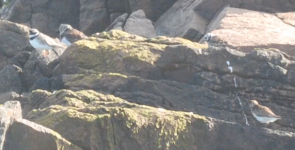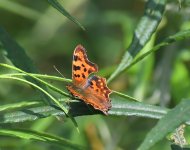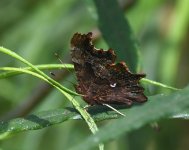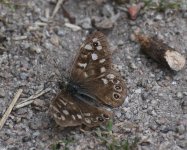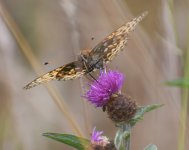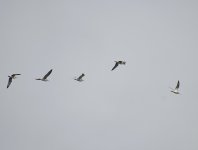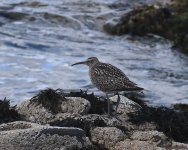-
Welcome to BirdForum, the internet's largest birding community with thousands of members from all over the world. The forums are dedicated to wild birds, birding, binoculars and equipment and all that goes with it.
Please register for an account to take part in the discussions in the forum, post your pictures in the gallery and more.
You are using an out of date browser. It may not display this or other websites correctly.
You should upgrade or use an alternative browser.
You should upgrade or use an alternative browser.
Birds fae Torry (1 Viewer)
- Thread starter Andrew Whitehouse
- Start date
More options
Who Replied?
Yes, looks like it.Were they a ringed plover, several turnstones and on dunlin on the Greyhope rocks today?View attachment 1459097
Cucurrucucu
Cucurrucucu
Are the (5 or 6) dead birds on South Breakwater gulls?

In an unusual move, I was back birding in Torry again today. It was a bit of a scorcher out there, so I waited until the relative cool of the evening to have a look around the headland. Things were mostly as expected for the season. 55 Goosander were gathered and there was a reasonable selection of waders in Greyhope Bay, including three Dunlin and three Knot. Sadly, a Kittiwake on the rocks looked as though it was succumbing to bird flu. An impressive 98 Swifts were over Torry at dusk.

Had a wander round St Fittick's this evening. It was pretty quiet but two Common Sandpipers were in Nigg Bay.

I looked around the headland this evening. It was pretty quiet but there were reasonable numbers of waders around, including a Knot and Dunlin in Greyhope Bay and two Common Sandpipers again in Nigg Bay. Almost nothing was moving offshore, unusually. 78 Swifts were over Torry.

I had a pleasant walk around the headland this morning. One species on the move today was Canada Goose, with two groups totalling 71 going north. The usual waders were around in Greyhope Bay, with a Knot and Dunlin again about. Things were still quiet offshore but six Teal and three Puffins went north. A Harbour Porpoise was also around.

It was a pleasant evening for a stroll around the headland. 74 Goosanders were in the harbour and waders included three Dunlin. The sea was more diverting than it has been for a while. Two Arctic skuas drifted north, doing the odd bit of harassment as they went. Nine Manx Shearwaters also went through and a couple of Harbour Porpoises included one quite close in. Better still, a Minke Whale surfaced twice about a kilometre out as it headed south.

Another lovely, warm evening here in Torry. A juvenile Goldeneye was among the Goosanders in the harbour. I was surprised to see a Snipe flying up from the rocks in Greyhope Bay. Three Manx Shearwaters went north offshore.

It's been fairly quiet here over recent days but today did produce a patch first, albeit not an avian one. A Comma gave very good views in St Fittick's this morning. It's not too big a surprise to get one here, as they've been starting to appear in the Aberdeen area for a while now.
Otherwise, very little to report, particularly as the haar came in this evening to spoil any prospects around the headland. Swifts seem to be departing now, with just 25 around last night.
Otherwise, very little to report, particularly as the haar came in this evening to spoil any prospects around the headland. Swifts seem to be departing now, with just 25 around last night.
Attachments

Once again, it was fairly quiet for birds. Butterflies were of more note, with a Speckled Wood around St Fittick's and a Dark Green Fritillary seen nicely on the north bank of the headland.
A Golden Plover circling over the golf course was my first on patch this year. Offshore, 15 Manx Shearwaters and an Arctic Tern went north. A Purple Sandpiper on the south harbour breakwater was my first of the autumn, thus kicking the Totaliser off. Also in that area was a striking leucistic Kittiwake, which looked almost totally white in flight. I had seen it a few days ago but got better looks today. My first juvenile Knot of the autumn was in the wader roost and 90 Goosander were in the harbour.
A Golden Plover circling over the golf course was my first on patch this year. Offshore, 15 Manx Shearwaters and an Arctic Tern went north. A Purple Sandpiper on the south harbour breakwater was my first of the autumn, thus kicking the Totaliser off. Also in that area was a striking leucistic Kittiwake, which looked almost totally white in flight. I had seen it a few days ago but got better looks today. My first juvenile Knot of the autumn was in the wader roost and 90 Goosander were in the harbour.
Attachments

It was a refreshingly cold evening for a wander around the headland. Waders included two Knot and a Sanderling. Seawatching was fairly slow but did feature two Arctic Skuas, seven Manx Shearwaters, seven Teal and six Arctic Terns.

I suspected today might be a bit interesting and so it proved. The weather was generally rather fine and sunny, although still a bit chilly. The wind gradually drifted around to the east and remained fairly light. After yesterday's strong northerlies, I suspected this would do the trick and bring a few good seabirds through. A report of a Cory's Shearwater off Inverbervie fuelled my interest and I headed out late morning to see what was going through.
Initially, the seawatching was fairly mundane, although there was a steady passage of Manx Shearwaters. An Arctic Skua was rather distant but that was about it. Eventually, my first Sooty Shearwater of the autumn headed north in the middle distance. That was encouraging but things began to quieten down after 2pm so I was thinking of maybe doing something else. On my last scan I picked out what was obviously a large shearwater heading north, although it (like a lot of today's birds) was following an oblique line slightly away from the coast rather than along, which made it hard to see the head. As it came north, it eventually got more sideways on and I was able to confirm what I had suspected from the shape and flight action: this my first Girdle Ness Great Shearwater. I followed it north for a few minutes until it was lost in the haze and became more distant.
I packed up soon after but, as I was doing so, a group of Whimbrel flew overhead calling. I had assumed that all six birds were Whimbrel but, on checking my photos, realised one of them was a Bar-tailed Godwit. I also picked out a juvenile Black Guillemot on the sea with the Eiders.
I headed back around the headland but, as I did so, got reports of more large shearwaters heading north off Inverbervie. I decided to head back to the foghorn, where I spent the rest of the afternoon seawatching, along with a few others. Sadly, none of the reported shearwaters made their way past. I suspect that birds were not really following the coastline much today, something indicated by the oblique lines many birds were flying along. It was probably pot luck whether the good stuff came within sight of wherever anyone was seawatching. Manx Shearwaters continued to go past, giving a day total of 141. There were also three Arctic Terns, six Arctic Skuas and a Bonxie. The latter was my first on patch of the year; it's a bit strange to get my first Great Skua after Great Shearwater.
On the way back, a Dunlin was on the breakwater and my first Wheatear of the autumn was along the north shore.
Initially, the seawatching was fairly mundane, although there was a steady passage of Manx Shearwaters. An Arctic Skua was rather distant but that was about it. Eventually, my first Sooty Shearwater of the autumn headed north in the middle distance. That was encouraging but things began to quieten down after 2pm so I was thinking of maybe doing something else. On my last scan I picked out what was obviously a large shearwater heading north, although it (like a lot of today's birds) was following an oblique line slightly away from the coast rather than along, which made it hard to see the head. As it came north, it eventually got more sideways on and I was able to confirm what I had suspected from the shape and flight action: this my first Girdle Ness Great Shearwater. I followed it north for a few minutes until it was lost in the haze and became more distant.
I packed up soon after but, as I was doing so, a group of Whimbrel flew overhead calling. I had assumed that all six birds were Whimbrel but, on checking my photos, realised one of them was a Bar-tailed Godwit. I also picked out a juvenile Black Guillemot on the sea with the Eiders.
I headed back around the headland but, as I did so, got reports of more large shearwaters heading north off Inverbervie. I decided to head back to the foghorn, where I spent the rest of the afternoon seawatching, along with a few others. Sadly, none of the reported shearwaters made their way past. I suspect that birds were not really following the coastline much today, something indicated by the oblique lines many birds were flying along. It was probably pot luck whether the good stuff came within sight of wherever anyone was seawatching. Manx Shearwaters continued to go past, giving a day total of 141. There were also three Arctic Terns, six Arctic Skuas and a Bonxie. The latter was my first on patch of the year; it's a bit strange to get my first Great Skua after Great Shearwater.
On the way back, a Dunlin was on the breakwater and my first Wheatear of the autumn was along the north shore.
Attachments

It's been much quieter over recent days. Today was pleasant and there did seem to be a bit moving. A good selection of waders included a Sanderling on the middle pier, a Dunlin and a Golden Plover in Greyhope Bay and five Knot went south. 17 Ringed Plovers was a high total. The sea was quiet but six Shelduck going south were the first for a while.

A fairly sedate but reasonably interesting day in Torry today, in fine weather. A look around the headland produced similar birds to yesterday with the Golden Plover and Sanderling both still present, along with a Dunlin and a Knot (two were present in the evening). A strikingly short-billed Whimbrel was along the north shore - presumably a young bird. It was trailing its right leg in flight and seemed unable to stand on that foot. I hope it's able to feed well enough to make it south.
An evening seawatch with Mark was mostly quiet, with just a couple of Manx Shearwaters north and two Shelduck south, before Mark picked out a distant but quite distinctive Balearic Shearwater heading north. My fourth species of shearwater in a week and only my third ever record here.
An evening seawatch with Mark was mostly quiet, with just a couple of Manx Shearwaters north and two Shelduck south, before Mark picked out a distant but quite distinctive Balearic Shearwater heading north. My fourth species of shearwater in a week and only my third ever record here.
Attachments
Last edited:
birdmeister
Well-known member

We've had a young Snowy Egret stop by for a rare visit on my local patch. Its foot is injured very similar to your Whimbrel (it's unable to stand or splay the toes forward). It limps but still runs and feeds well, even evading a juvenile Peregrine the other day.A fairly sedate but reasonably interesting day in Torry today, in fine weather. A look around the headland produced similar birds to yesterday with the Golden Plover and Sanderling both still present, along with a Dunlin and a Knot (two were present in the evening). A strikingly short-billed Whimbrel was along the north shore - presumably a young bird. It was trailing its right leg in flight and seemed unable to stand on that foot. I hope it's able to feed well enough to make it south.
An evening seawatch with Mark was mostly quiet, with just a couple of Manx Shearwaters north and two Shelduck south, before Mark picked out a distant but quite distinctive Balearic Shearwater heading north. My fourth species of shearwater in a week and only my third ever record here.

That's good to know. I guess leg injuries are not uncommon in wading birds and they seem to have ways of coping.We've had a young Snowy Egret stop by for a rare visit on my local patch. Its foot is injured very similar to your Whimbrel (it's unable to stand or splay the toes forward). It limps but still runs and feeds well, even evading a juvenile Peregrine the other day.

Another interesting evening here in Torry. I originally went out to look for a Black Tern that a few others had seen. Sadly, it had disappeared. A couple of Wheatears were in Greyhope Bay on the way out. I started seawatching but things were fairly quiet, aside from a steady stream of Manx Shearwaters heading north at fairly close range. I was about to head home when I picked out a dark shearwater going north around 500 metres away. From the size, pattern and flight it was clearly a Balearic Shearwater: my second in a few days but only my fourth here ever. It was followed a few minutes later by another heading along exactly the same line. This species seems to be getting more frequent in the North Sea these days and I wouldn't be surprised if more are seen in the coming weeks. I also saw 26 Manx Shearwaters, an Arctic Skua, 24 Arctic Terns and three Teal.

This evening was pleasant and also rather lively. A Whimbrel was in Greyhope Bay and a juvenile Kestrel by Nigg Bay was my first for a while. There were lots of feeding groups out to sea, which include a very close Sooty Shearwater that wandered around repeatedly in between bouts on the water. Also on the move were a Goldeneye, four Common Scoter, four Arctic Terns, five Arctic Skuas and five Manx Shearwaters. There were still six Swifts gathering over Torry at dusk, as well as at least 40 House Martins. A flock of seven Canada Geese went north.
Last edited:
Users who are viewing this thread
Total: 2 (members: 0, guests: 2)




